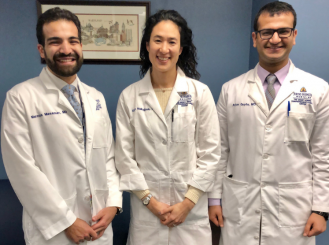By Arjun Gupta, MD, Erica Nakajima, MD, and Ramy Sedhom, MD
The inpatient solid tumor oncology is traditionally recognized as an unpopular rotation among internal medicine residents. At two of our previous training institutions, residents had voted overwhelmingly to remove it as a compulsory rotation. A survey of internal medicine residents at an academic U.S. medical center, published in 2016 in the Journal of Oncology Practice, revealed that residents had a decreased interest in pursuing an oncology career after an inpatient hematology-oncology ward rotation. Usually these services are high-volume with rapid patient turnover. Patients are often admitted for complications of cancer and/ or its therapy—including infections, blood clots or bleeding, clogged tubes, and symptom control (pain, nausea, constipation). Internal medicine residents who walk into these rotations without a sense of the complete oncology experience—which is largely outpatient—get a very skewed picture regarding what oncologists do and, more importantly, how patients with cancer do. As more chemotherapy regimens are moved to the outpatient setting, trainees have fewer opportunities to care for patients receiving cancer treatment on the inpatient service. Caring for patients receiving therapies that are simply acronyms (FOLFOX, ECF, BEP) without context or meaning furthers the disconnect between trainees, the field of oncology, and the patient experience. Residents who are undifferentiated towards pursuing oncology see a patient admitted with severe, uncontrolled symptoms, and have an unfavorable impression of oncology.
With this background, we started the inpatient solid tumor oncology service as oncology fellows with some trepidation. Unlike the other largely outpatient tumor site-directed rotations in fellowship (gastrointestinal/genitourinary/breast/lung), which had a rather predictable patient population and schedule, the inpatient service was a potpourri of everything. You never knew what cancer and condition the next patient might have: small cell lung cancer with superior vena cava syndrome, Pneumocystis pneumonia in a patient with glioblastoma, cholangitis from malignancy-induced biliary obstruction, or severe mucositis requiring parenteral nutrition. It was hard to know what was next. As one of our co-fellows commented as she signed out patients to us the evening before we started the rotation, ‘‘This is medicine on steroids.'' We realized the next day that she had been right! Several patients on the service were literally on steroids—for severe immune-related adverse effects, for cauda equina syndrome, for bone pain and nausea. It really was internal medicine, but patients were on average sicker, multiple specialists were involved in their care, family members were (appropriately) more anxious, and there was frequent ongoing communication with the primary oncologists. In all this, it was not hard to see how a new resident or even a fellow could be overwhelmed.
Based on our experiences as first-year fellows on the inpatient oncology service, here are some learnings, tips, and advice for a rewarding and educational experience. These are largely for first-year fellows but are broadly applicable to senior residents interested in pursuing a career in oncology.
1. Take a step back and look at the bigger picture. Often, we are informed of an incoming admission by the primary oncologist, triage nurse, or emergency department. A sample page to the admitting team might be ‘’67 yo with tongue cancer, radiation induced mucositis, dehydration, AKI.’’ It is simple to label patients like this, but it is dehumanizing. As busy as we are documenting and putting in orders, taking a couple of minutes, perhaps at 3 PM after things have settled, to go hold someone’s hand can be very therapeutic for the patient, and for us. We can learn a lot about our patients (and medicine and oncology) if we take a minute to ask them what they were doing 2 weeks ago, their favorite ice cream flavor, and the name of their dog. This is similar to the Tell Me More® campaign by the Gold Foundation, which encouraged housestaff to learn three non-medical things about their patients. Housestaff who participated had fewer burnout-related symptoms.
2. Teach. There is no perfect time to teach—with the clinical workload, switching teams, running to clinic, and respecting resident duty hours, there will not be a time when you will get 30 undisturbed minutes with six residents/students, a nice quiet room, and a whiteboard. Make small pithy teaching points on rounds. As new fellows, we don’t know everything, but we know more than we think we do. Simple concepts (such as adjuvant vs. neoadjuvant therapy, mechanisms of actions of certain chemotherapies, why they are used in a certain cancer) can sometimes be communicated in under a minute. If you read a cancer topic, try teaching it to the residents the next day. There is no better way to learn than to teach. It is also important to teach to one’s audience. A neurology preliminary resident may be fascinated by the cognitive decline experienced by patients following chemotherapy. Those interested in primary care may want to learn about screening guidelines and survivorship. Someone going into obstetrics/gynecology may be curious about fertility preservation with chemotherapy.
3. Be willing to learn. Take the opportunity to ask attendings about their fields. Faculty are often super-specialized, especially in academic centers, and they can have great insight into a disease process or site. If you have the world’s authority on small cell lung cancer as the attending on service, ask them what they think about the IMPower133 trial that was just published, as was the case with us. Learn also from your housestaff, students, and all members of the care team. The experienced nurse can probably teach you more about managing radiation dermatitis than any textbook. The emergency medicine resident who first evaluated the patient with hemorrhagic pericardial effusion can show you more point-of-care-ultrasound cardiac views than you knew existed. The veteran social worker can identify an uncomplaining but overwhelmed family within a couple of sentences of the conversation.
4. Care for the caregiver(s). When patients are first admitted, caregivers including family and friends are often in extremis—they are scared, they have been trying to manage symptoms at home, and they may have a sense of failure. A caregiver’s anxiety can be at an all-time high. It is our job to also treat them. It is also important to explore the caregiver experience and to arrange safe disposition for our patients in their care transitions. Coordinating family meetings, updating family members, confirming that they are engaged and comfortable with the plan (driving to appointments, helping with administering enoxaparin shots, etc.) will only ensure better outcomes for our patients.
5. Prepare. Although there are innumerable reasons why patients may be admitted, certain topics are overrepresented. It is not uncommon to see patients with these conditions admitted every call cycle: neutropenic fever, cord compression, immune-related adverse events, bowel obstruction, cancer pain, mucositis, venous thromboembolism, and line infections. This is part of core medicine but may be worth revising if it has been a few months.
6. Become proficient at end-of-life conversations. As fellows, one rewarding aspect of this rotation is working with residents on how to carry out difficult conversations about the end of life with grace and humanity. Residents often do not receive guidance on how to discuss preferences with patients or receive opportunities to be evaluated by a preceptor. The natural tendency of trainees is to focus on the code status, which is an important but not a comprehensive assessment of a patient’s goals of care. There is no one-size-fits-all method, but multiple resources exist to help prepare and practice.
7. Learn more about palliative and supportive care. There is perhaps no better place to learn these skills. Sit in with the palliative consultant to learn how they assess and address nausea—check for obstruction/bowel movement, type of nausea, co-existing pain and anxiety—instead of just writing the cliched “ondansetron as needed” order. For one of us, a first interaction with the palliative care team inpatient is where we learnt that “magic mouthwash” is not a single, fixed formulation, which led to a research idea and project.
8. Recognize that it takes a village. Medical oncology, surgery, radiation, nursing, pharmacy, interventional radiology, palliative care, nutrition, social work, physical, occupational, and speech and language therapists... It takes a village to care for a patient with cancer, as they say. If you didn’t realize that yet, you will be forced to now. By working with and learning from this multidisciplinary team, we gain a greater appreciation of what patients go through, and can become aware of some hitherto underappreciated toxicities of cancer care—social isolation, financial toxicities, loss of independence, and caregiver burden (see point 3).
9. This service is an ode to the busy oncologist. Despite all your work caring for the patient, it is not uncommon for the patient to reply with, “Thank you, but does my primary oncologist agree with this plan?’’ We realized how relationships are built over time, how much oncologists invest in their patients’ care, and how much patients appreciate and trust their oncologists. It is not without reason or reciprocation; some oncologists would swing by to the inpatient unit at 8 PM after a busy clinic day, others would call in to the patient's room a few hours after presenting at a major conference in Europe. It inspires us to be better oncologists.
10. It is humbling. As fellows, it is a relatively humbling experience to have a patient for whom you are the primary oncologist admitted to the hospital. ‘’Did I not prescribe the nausea medicine correctly? Did I triple-check the chemotherapy doses? Did I miss an early sign that an infection was brewing when the white cell count went from 6,000 to 8,000?’’—these are all questions we have mulled over. It is important to realize that some admissions are not preventable and despite all our care and caution, patients sometimes need to be admitted. Even at this time, the graciousness of patients and their capacity for concern and love for you—‘'I am very sick, doc. But I will be fine. Don’t worry about me'’—is massively rewarding.
In conclusion, we are in awe of the resiliency of our patients. No one likes to be in the hospital, least of all someone with a potentially short life expectancy in front of them. They face up to the odds, and the ever-present risk of morbidity and death, with courage. They are selfless and go through many of the inefficiencies of cancer care without grumbling. They deserve better, and we should be encouraged to improve the patient experience, whether through breakthrough research or improvements in the quality of cancer care. We hope our experience helps and encourages you to enjoy your time on the inpatient rotation more, so that patients admitted can have a happier, more fulfilled doctor.
Dr. Gupta, Dr. Nakajima, and Dr. Sedhom are first-year medical oncology fellows at the Sidney Kimmel Comprehensive Cancer Center at Johns Hopkins. Follow them on Twitter @guptaarjun90, @erica_nakajima, and @ramsedhom.



Recent posts